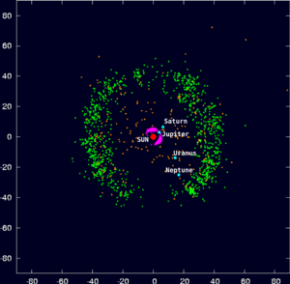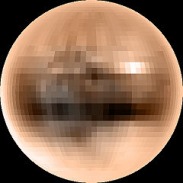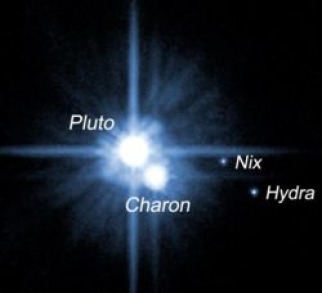Kuiper Belt

The Kuiper belt (pronounced /ˈkaɪpɚ/, to rhyme with "viper"),[1] sometimes called the Edgeworth-Kuiper belt, is a region of the Solar System beyond the planets extending from the orbit of Neptune (at 30 AU) to approximately 55 AU from the Sun.[2] It is similar to the asteroid belt, although it is far larger; 20 times as wide and 20–200 times as massive.[3][4] Like the asteroid belt, it consists mainly of small bodies (remnants from the Solar System's formation) and at least one dwarf planet – Pluto. But while the asteroid belt is composed primarily of rock and metal, the Kuiper belt objects are composed largely of frozen volatiles (dubbed "ices"), such as methane, ammonia and water.
Since the first was discovered in 1992, the number of known Kuiper belt objects (KBOs) has increased to over a thousand, and more than 70,000 KBOs over 100 km in diameter are believed to reside there.[5] The Kuiper belt was initially believed to be the main repository for periodic comets, those with orbits lasting less than 200 years. However, studies since the mid-1990s have shown that the Kuiper belt is dynamically stable, and that it is the farther scattered disc, a dynamically active region created by the outward motion of Neptune 4.5 billion years ago, that is their true place of origin.[6]Scattered disc objects such as Eris are KBO-like bodies with extremely large orbits that take them as far as 100 AU from the Sun. The centaurs, comet-like bodies that orbit among the gas giants, are believed to originate there. Neptune's moon Triton is believed to be a captured KBO.[7] Pluto, a dwarf planet, is the largest known member of the Kuiper belt. Originally considered a planet, it is similar to many other objects of the Kuiper belt, and its orbital period is identical that of the KBOs known as "Plutinos".
The Kuiper belt should not be confused with the hypothesized Oort cloud, which is a thousand times more distant. The objects within the Kuiper belt, together with the members of the scattered disc and any potential Hills cloud or Oort cloud objects, are collectively referred to as trans-Neptunian objects (TNOs).[8]
Pluto

Pluto (pronounced /ˈpluːtoʊ/ (help·info), from Latin: Plūto, Greek: Πλούτων), also designated 134340 Pluto, is the second-largest known dwarf planet in the Solar System (after Eris) and the tenth-largest body observed directly orbiting the Sun. Originally classified as a planet, Pluto is now considered the largest member[7] of a distinct region called the Kuiper belt. Like other members of the belt, it is composed primarily of rock and ice and is relatively small: approximately a fifth the mass of the Earth'smoon and a third its volume. It has a highly eccentric and highly inclined orbit. The eccentricity takes it from 30 to 49 AU (4.4–7.4 billion km) from the Sun, causing Pluto to occasionally come closer to the Sun than Neptune. Pluto and its largest moon, Charon, are often treated together as a binary system because the barycentre of their orbits does not lie within either body.[8] The International Astronomical Union (IAU) has yet to formalise a definition for binary dwarf planets, and until it passes such a ruling, Charon is classified as a moon of Pluto.[9] Pluto has two known smaller moons, Nix and Hydra, discovered in 2005.[10]
From its discovery in 1930 until 2006, Pluto was counted as the Solar System's ninth planet. In the late 20th and early 21st centuries, however, many objects similar to Pluto were discovered in the outer solar system, notably the scattered disc object Eris, which is 27% more massive than Pluto.[11] On August 24, 2006 the IAU defined the term "planet" for the first time. This definition excluded Pluto, which the IAU reclassified as a member of the new category of dwarf planets along with Eris and Ceres.[12] After the reclassification, Pluto was added to the list of minor planets and given the number 134340.[13][14]
Moons of Pluto

The innermost moon, Charon, was discovered by James Christy on 1978June 22, nearly half a century after Pluto. Two outer moons were imaged by the Hubble Space Telescope Pluto Companion Search Team on 2005May 15, and precovered from Hubble images taken in June 2002. With the orbits confirmed, the moons have been given definitive names: Hydra (Pluto III, formerly S/2005 P 1) and Nix (Pluto II, formerly S/2005 P 2). The names were chosen in part because the initials (NH) allude to the New Horizons mission [1]. Further Hubble observations were made in February and March 2006. Given the sensitivity of the Hubble images, and the fact that the entire region of space dominated by Pluto's gravitational field has been imaged, Pluto is not expected to have any other moons larger than approximately 12 km in diameter with the albedo of Charon, or possibly up to 40 km if they are as dark as the darkest Kuiper Belt objects. The possibility of rings created by impacts on the smaller moons will be investigated by the New Horizons probe.
The Plutonian system is highly compact: The three known satellites orbit within the inner 3% of the region where prograde orbits would be stable.
Pluto and Charon have been called a double planet because Charon is larger compared to Pluto (half its diameter and an eighth its mass) than any other moon is to a planet; indeed Charon is massive enough that, despite their proximity, Pluto orbits the system's barycenter at a point outside its surface.[2] Charon and Pluto are also tidally locked, so that they always present the same face toward each other.
Following Buie and Grundy's recent re-calculations taking into account older images, the orbits of the moons are confirmed to be circular and coplanar, with inclinations differing less than 0.4° and eccentricities less than 0.005. The inclinations are roughly 96° to the ecliptic (so technically the moons' movements are retrograde). The diagram on the right shows the view from the axis of the moons' orbits (declination 0°, right ascension 133°), aligned with the HST diagram above it. As seen from Earth, these circular orbits appear foreshortened into ellipses depending on Pluto's position.[3]
The Plutonian system has not been visited by spacecraft, but a flyby by the New Horizons mission is due in July 2015.
